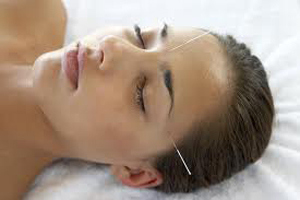Acupuncture – Great for Treating Migraines
Add acupuncture to your migraine treatment strategy.
Why?
 Because it works! Not only can acupuncture quiet down an active migraine episode, it can even prevent a migraine from starting up in the first place. Acupuncture can improve the quality of life for many migraine sufferers.
Because it works! Not only can acupuncture quiet down an active migraine episode, it can even prevent a migraine from starting up in the first place. Acupuncture can improve the quality of life for many migraine sufferers.
How Does Acupuncture Help Migraines?
To better understand how acupuncture can help people with migraines, first understand that the core philosophy of Traditional Chinese Medicine (TCM), is that imbalances in the flow of blood and energy called Qi creates tension that causes these kinds of conditions to happen. So treating the condition means relieving the tension by restoring balance to blood flow and Qi.
The Acupuncture specialist relieves this tension by gently inserting tiny sterile needles into specific points on the body to remove blockages and improve the blood flow to the brain. This helps reduce the pain experienced during an active migraine attack.  The stimulation of these specific points with the needles is thought to help the body re-balance the serotonin levels. Serotonin is a chemical produced in the brain that affects blood vessel function which has a role to play in migraines. It does take more than one session however. In fact, in the beginning of your treatment plan, the more frequent these acupuncture sessions are the better. This helps to chip away at whatever is blocking healthy flow until a healthier flow pattern is established. Over time the frequency of treatment session will decrease as the effectiveness of each session starts to last longer and longer. Key aspects of acupuncture are that there are no negative side effects and it is basically painless. Skillful professionals can do this so you hardly even notice that a treatment is being done. How well acupuncture relieves migraine pain from one person to another varies. The individual response depends on the specific condition and the individual.
The stimulation of these specific points with the needles is thought to help the body re-balance the serotonin levels. Serotonin is a chemical produced in the brain that affects blood vessel function which has a role to play in migraines. It does take more than one session however. In fact, in the beginning of your treatment plan, the more frequent these acupuncture sessions are the better. This helps to chip away at whatever is blocking healthy flow until a healthier flow pattern is established. Over time the frequency of treatment session will decrease as the effectiveness of each session starts to last longer and longer. Key aspects of acupuncture are that there are no negative side effects and it is basically painless. Skillful professionals can do this so you hardly even notice that a treatment is being done. How well acupuncture relieves migraine pain from one person to another varies. The individual response depends on the specific condition and the individual.
Benefits of Less Migraine Pain
The end result of incorporating acupuncture into your care can be amazing, if not life altering. If you experience 15 to 20 days a month of excruciating pain, acupuncture may be able to decrease that down to only 8 days, with those days not having the severity of pain as before. You may not even need to use that much medication as you did before. If you have a job, less pain days is good so you are not absent from work as much and won’t lose money or risk losing your job all together.
What Does the Science Say?
Acupuncture has been practiced in the United States for over 2 decades now. Various research studies have demonstrated its effectiveness in treating a variety of chronic conditions and certain addictions. Although one study has shown that acupuncture helps migraines1, other research still needs to be done to verify those results and satisfy the scientific community. Until other positive results are published, conventional medicine prescribed by your doctor is still the primary approach to treating migraines. Despite the lack of hard scientific data, acupuncture is worth a try. If it can help manage the frequency of your migraines, the intensity of your migraine pain, and help decrease the amount of medication you need to have a higher quality of life…..Why not give it a try? Just ask your doctor for a referral. There are more and more healthcare practitioners around who accept the fact that alternative forms of medicine can also help their patients.
In addition to adding acupuncture, it may also be helpful for you to make some lifestyle changes since there are various factors that are known to trigger migraines. Stress is number one on that list. So here is another reason for you to get enough rest, exercise, and maintain a balanced diet.
Is It Covered By My Insurance?
This is a common and more frequently asked question these days. You should also check to see if acupuncture is covered by your healthcare plan. More health insurance providers and HMO’s these days are starting to cover all or part of the cost of acupuncture treatments for specific conditions but many have restrictions. So check what is covered by your policy.
1Arch Intern Med. 2012;172(19):1444-1453. doi:10.1001/archinternmed.2012.3654
